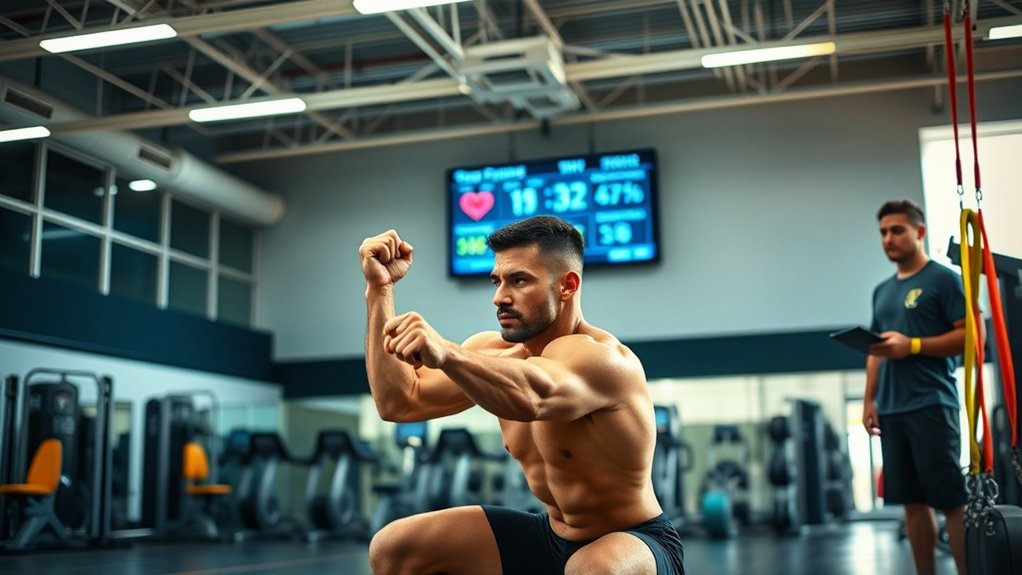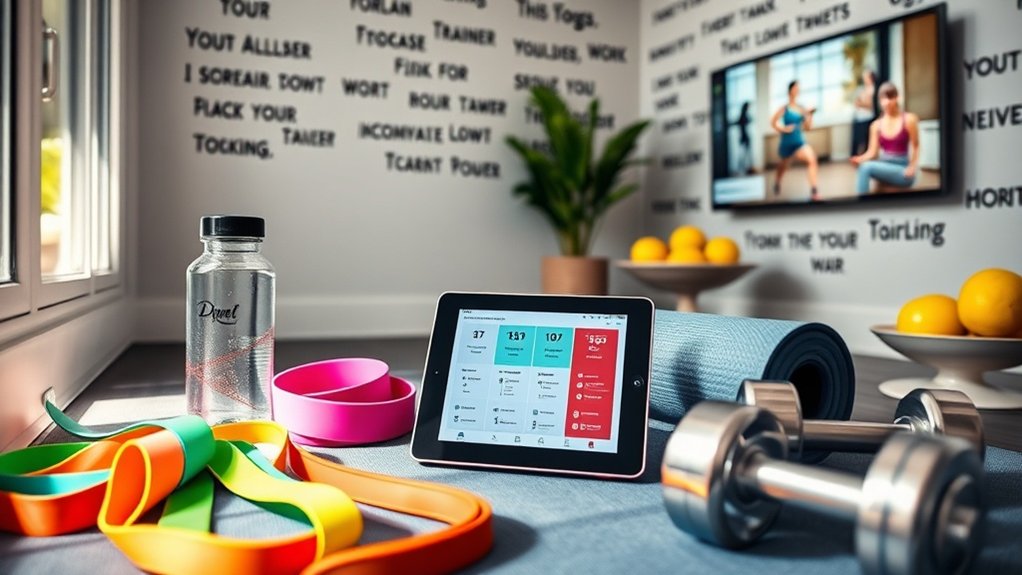Your personalized athletic performance plan requires systematic periodization across 6-12 month macrocycles, dividing training into off-season foundational work, pre-season skill sharpening, and in-season high-intensity sessions. You’ll integrate Olympic lifts generating 4,000+ watts of peak power with plyometric protocols that boost vertical jump by 8-12%. Biomechanical assessments identify positional demands while load management reduces injury risk by 30-40%. Evidence-based recovery strategies—including cryotherapy and compression therapy—accelerate healing by 30%. The extensive framework below details protocols that’ll transform your training architecture.
How Elite Athletes Structure Their Training Programs

Elite athletes construct their training programs through systematic periodization models that integrate multiple performance domains simultaneously. You’ll notice their sports performance training divides into distinct microcycles, mesocycles, and macrocycles, each targeting specific adaptations.
Your weekly structure balances stress and recovery—Monday might emphasize lower-body strength development, Tuesday focuses on speed mechanics, Wednesday incorporates active recovery protocols, Thursday targets upper-body power, and Friday refines sport-specific technical skills.
Training plans rely heavily on data-driven assessments. You’ll track biomechanical markers, force production metrics, and movement efficiency scores to identify performance gaps. These objective measurements inform program adjustments every 2-4 weeks.
Your individualized approach accounts for positional demands, competitive schedule, and recovery capacity. Advanced technologies monitor training load, neuromuscular fatigue, and readiness indicators, confirming you’re optimizing adaptation while minimizing injury risk through evidence-based progression strategies.
Building Explosive Power Through Olympic Lifts and Plyometrics
Your explosive power development hinges on three critical components: mastering Olympic lift mechanics to maximize force production across multiple joints, designing plyometric protocols that target specific rate of force development (RFD) adaptations, and implementing progressive overload strategies that systematically improve your power output.
Research demonstrates that combining these elements can yield 10-20% improvements in vertical jump performance and 30% increases in reactive strength index when properly periodized.
You’ll need to understand how proper technique execution, training volume manipulation, and recovery integration interact to optimize neuromuscular adaptations for sport-specific power expression.
Olympic Lift Technique Fundamentals
Olympic lifts generate peak power outputs exceeding 4,000 watts in trained athletes—significantly higher than traditional strength training movements—making them essential tools for developing sport-specific explosiveness.
Your performance depends on mastering triple extension mechanics, where coordinated ankle, knee, and hip extension generates maximum force production. You’ll start with lighter loads, prioritizing technical precision before progressing to heavier weights that maximize power development.
Technical fundamentals you must master:
- Hip extension dominance – Drive force generation from posterior chain activation rather than arm pulling
- Catch position stability – Develop mobility and strength to receive the bar efficiently
- Progressive loading protocols – Increase weight only after demonstrating consistent technique at 85% proficiency
- Plyometric integration – Combine box jumps with Olympic lifts for improved rate of force development
- Movement coordination – Synchronize triple extension timing to optimize power transfer
Plyometric Training Protocol Design
When integrated systematically, plyometric protocols amplify the neuromuscular adaptations gained from Olympic lifting by targeting the stretch-shortening cycle—the mechanism responsible for generating elastic energy during rapid eccentric-to-concentric shifts.
Your plyometric training should include depth jumps, bounding variations, and box drills performed 1-3 times weekly, allowing 48-72 hours between sessions for peak performance and recovery.
Research demonstrates that combining these explosive movements with Olympic lifts increases vertical jump height by 8-12% and sprint acceleration by 5-8% within 8-week mesocycles.
Structure your protocol using progressive overload: begin with bilateral exercises at lower intensities (60-80 ground contacts per session), then advance to unilateral and multi-directional patterns.
Prioritize landing mechanics and force absorption technique before increasing volume or complexity, as proper execution reduces injury risk while maximizing power output adaptations.
Power Development Progression Strategies
Because peak power output requires coordinated development of force production and velocity components, you must structure your training progression through three distinct phases that systematically build upon each other.
Begin with foundational strength through bodyweight movements, advance to Olympic lifts for explosive strength-speed development, then integrate plyometrics for maximal velocity expression. Research demonstrates this sequential power development approach yields 15-30% increases in peak output when tailored to your performance needs.
Phase-Specific Training Protocols:
- Phase 1 (Weeks 1-4): Master bodyweight mechanics—squats, lunges, push-ups—establishing movement patterns and joint stability.
- Phase 2 (Weeks 5-10): Introduce Olympic lift variations—hang cleans, power snatches—emphasizing technical proficiency before load progression.
- Phase 3 (Weeks 11-16): Implement plyometric drills—depth jumps, bounding—focusing on minimal ground contact time.
- Load Management: Progress resistance by 2-5% weekly while maintaining pristine technique.
- Recovery Integration: Schedule 48-72 hours between high-intensity power sessions for peak neuromuscular adaptation.
Sport-Specific Movement Patterns and Position Demands
While generic training programs may build general fitness, sport-specific movement patterns form the foundation of elite athletic performance by targeting the precise biomechanical demands your body encounters during competition.
Position demands notably influence your sports training requirements—a football lineman needs explosive power and lateral stability, while a soccer striker requires rapid directional changes and sustained speed.
At the Mass General Brigham Center for Sports Performance and Research, detailed biomechanical assessments identify your unique movement patterns, enabling researchers to create a tailored training program that develops position-relevant muscle groups and skills.
This targeted approach delivers measurable results: athletes training according to sport-specific patterns demonstrate performance improvements of up to 20% in speed and power output while simultaneously reducing injury risk through improved movement efficiency.
Periodization Models: Off-Season, Pre-Season, and In-Season Training

Your training program’s effectiveness depends on strategically dividing the competitive year into distinct periodization phases—off-season, pre-season, and in-season—each with specific volume and intensity parameters.
Research demonstrates that systematic manipulation of training loads across these phases reduces injury risk by 30-40% while optimizing neuromuscular adaptations and metabolic efficiency.
You’ll need to align your macrocycle structure with competition schedules, progressively shifting from high-volume, low-intensity work to sport-specific, high-intensity sessions as you approach peak performance windows.
Strategic Periodization Phases Explained
Strategic periodization divides your training year into distinct phases that systematically manipulate volume, intensity, and specificity to optimize athletic adaptation.
These strategic periodization models create a research-driven framework where your training program evolves based on competitive timelines and physiological responses. Each phase serves distinct purposes: off-season builds foundational capacity, pre-season sharpens sport-specific skills, and in-season maintains peak performance while managing fatigue accumulation.
Key components of effective periodization:
- Macrocycle planning spans 6-12 months, establishing your annual training architecture around competition schedules.
- Mesocycle blocks last 3-6 weeks, targeting specific adaptations like strength or power development.
- Microcycle adjustments occur weekly, balancing training stress with recovery demands.
- Performance monitoring tracks power output, velocity metrics, and readiness scores.
- Load management prevents overtraining through systematic variation of training stress.
Adapting Training by Season
Because athletic performance demands fluctuate throughout the competitive calendar, you’ll need distinct training strategies for each season that systematically manipulate training variables to maximize adaptation.
During off-season, you’ll prioritize strength and endurance development, building foundational fitness while minimizing injury risk through controlled volume progression.
Pre-season training shifts toward sport-specific skill refinement, incorporating speed and agility protocols that directly translate to competitive performance metrics.
In-season periodization focuses on maintaining peak output through strategic workload monitoring and recovery integration, preventing cumulative fatigue that compromises performance.
Research demonstrates that proper periodization across these phases yields measurable performance improvements and significant injury rate reduction.
Your training cycles must balance intensity fluctuations with adequate recovery periods, making sure ideal physiological adaptation while avoiding overtraining syndrome throughout the competitive year.
Performance Testing Protocols and Progress Tracking Systems
While establishing baseline metrics forms the foundation of effective training periodization, performance testing protocols serve as the systematic framework for quantifying athletic capacity across multiple physiological domains.
Your thorough assessment evaluates strength, flexibility, range of motion, and sport-specific movements during hour-long sessions. Performance technicians use sport science technology to analyze biomechanical patterns, informing evidence-based training modifications while mitigating injury risk.
Progress tracking systems enable continuous monitoring through:
- Baseline establishment via thorough strength and mobility assessments
- Individualized programming derived from evaluation data and recovery analytics
- Periodic reassessments that inform training plan evolution
- Device integration with Garmin and Strava for real-time metric synchronization
- Movement analysis using advanced tracking technology to optimize performance adaptations
These protocols guarantee your training remains responsive to physiological adaptations and performance objectives.
Recovery Strategies and Injury Prevention for High-Performance Athletes

Although systematic performance testing quantifies athletic capacity, recovery protocols determine your ability to sustain high-intensity training loads without accumulating physiological debt.
Extensive recovery strategies using state-of-the-art suites facilitate muscle healing and energy restoration essential for maintaining peak performance levels. Evidence-based techniques like cryotherapy and compression therapy improve muscle recovery time by approximately 30%, reducing training downtime considerably.
Your personalized plan integrates injury prevention protocols through biomechanical assessments that identify risk factors and inform exercise modifications.
Research demonstrates that proper recovery methods—including active recovery and adequate sleep—reduce overuse injury risk by up to 50%. Regular recovery analytics inform real-time training adjustments, boosting athletic resilience.
This data-driven approach guarantees you’re maximizing adaptation while minimizing injury potential through strategic recovery implementation.
Frequently Asked Questions
How Much Does a Personalized Athletic Performance Plan Typically Cost?
You’ll find investment levels vary considerably based on plan customization—typically $100-$500 monthly for digital programs, while in-person coaching reaches $200-$2,000+ monthly. Cost comparison data shows you’re paying for evidence-based programming, performance metrics tracking, and expert guidance.
Can Amateur Athletes Benefit From the Same Training as Professionals?
Yes, you’ll achieve similar training adaptations through professional protocols scaled to your capacity. Evidence shows properly periodized programs improve performance markers and injury prevention regardless of skill level, when intensity and volume match your physiological readiness.
What Qualifications Should I Look for in a Performance Coach?
Like choosing a surgeon, you’ll want verified credentials: seek coaches with CSCS or NSCA certification requirements, plus 3-5 years coaching experience with measurable athlete outcomes. Data-driven methodology and sport-specific expertise guarantee you’re investing in proven performance improvement.
How Long Before I See Measurable Improvements in My Performance?
You’ll notice initial improvements in 2-4 weeks, with significant performance benchmarks achieved in 8-12 weeks. Your performance timeline depends on training intensity, recovery protocols, and baseline fitness. Neuromuscular adaptations occur first, followed by cardiovascular and strength gains.
Do I Need Access to Specialized Gym Equipment to Start?
No, you don’t need specialized equipment initially. Evidence shows bodyweight exercises effectively build foundational strength, power, and mobility. A basic home gym setup—resistance bands, dumbbells, pull-up bar—sufficiently supports measurable athletic performance gains before progressing to advanced equipment.



